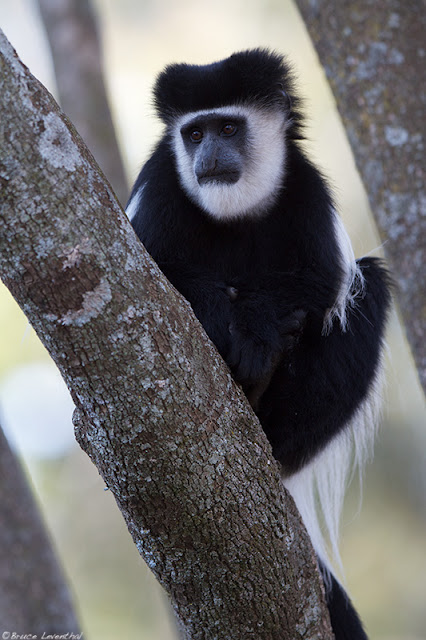Binocular vision - Upright posture - Generalized skeleton - Facial mobility - Grasping hands - Large brains
I've just described you and all of the other animals known as primates.
The word primate, like carnivore and rodent, is an order of mammal within the Linnean classification system. Unlike many mammals, the typical primate forgoes an acute sense of smell in favor of color vision and attention to auditory stimuli. Surprisingly, we can be more like tropical birds than our mammalian brethren. We are social, vocal, and hang out together. We are the product of our evolution... We are the tree dwellers in dark and damp forests, we see clearly, and we depend on memories to find the ephemeral fruits that feed our big brains. Our complex social structures and ability to communicate have enhanced our survival across the millennia, and have allowed us to thrive in a place that is inhospitable to most other mammals.
I am no portrait artist... I've got a lousy sense of timing, couldn't pose a model if my life depended on it, and can't recall the difference between a strobe and a flash. Nonetheless, I do love wildlife portraiture, and will take any opportunity I have to shoot natural portraits of anything whose brain is smaller than my own. While it's fun to photograph the big cats, rhinoceros, and elephants, nothing offers the expressiveness of a monkey or ape. It's their near human quality that captivates, makes us smile, and see our past in their present.
To photograph wild monkeys and apes, you need to be patient. Like human toddlers, they're always on the move, somewhat shy, and very unpredictable. However, if you are willing to wait it out, they can be amazingly expressive. While I always try to work from a tripod, I have found that I need to be more flexible when photographing primates. In general they do not come to you, instead you must listen for their calls, the leaps between trees, and find the focus of their attention... ripe fruit. Leave the tripod behind, turn on your image stabilization (vibration reduction for your Nikonians), and bump up that ISO. The tree canopy will be streaked with contrasty light from above, and the primates will hide within the shade of the tropical foliage. Unfortunately, this makes for very challenging photography. Nothing is harder on our digital media than a black and white animal under a dark canopy streaked with intermittent light. While I am generally not a fan of the following piece of advice, bracket your exposures and shoot a lot! I have learned to expect only a few good images from an encounter with a troop of monkeys, but if you're patient and willing to take a risk, the final images are worth the investment.
Image #1: Black and White Colobus Monkey. Lake Naivasha, Kenya. Canon 7D + 300 f2.8IS @ f3.2
Image #2: Olive Baboon in Tree Ngorongoro Crater, Tanzania. Canon 1DmkII + 300 f2.8IS + 1.4x converter @ f4.0
Image #3: Screaming Vervet. Lake Naivasha, Kenya. Canon 40D + 100-400IS @ f5.6
Image #4: White Faced Capuchin Monkey. Hacienda Baru, Costa Rica. Canon 40D + 300 f2.8IS @ f2.8
Image #5: Chimpanzees and Sugar Cane. Ol Pejeta Chimpanzee Protectorate, Kenya. Canon 7D + 300 f2.8IS @ f4.5
©2000-2011 BTLeventhal.com / Bruce & Tamy Leventhal. All rights reserved. No image on this site may be used without permission





No comments:
Post a Comment